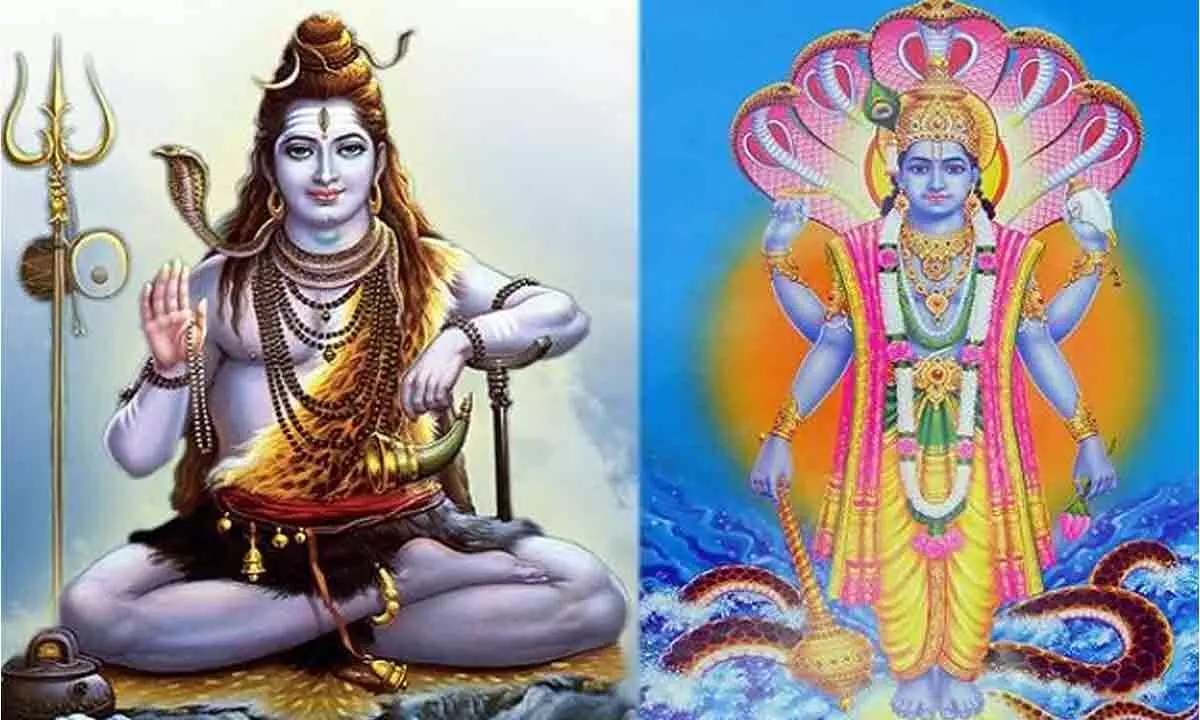Live
- FIH Women’s Pro League: England thwart India fightback, win bonus point in shootout
- Metro Railway Kolkata to evacuate stranded rakes from tunnels using battery power
- Controversy Over Congress President’s Remarks on Maha Kumbh Mela
- CM Urges H.D. Deve Gowda to Stand Above Politics for Karnataka’s Water Rights
- Unseeded Kyrian Jacquet upsets second seed Billy Harris to win Delhi Open 2025 singles title
- India headed to become $30-35 trillion economy in next two decades: Piyush Goyal
- Medical Students to Adopt Rural Families as NMC Pushes for Community-Based Learning
- Central Railway runs special trains, improves crowd management for Mahakumbh devotees
- Yamuna's cleaning drive in Delhi: PM Modi's pre-election promise now in action
- IPL 2025: LSG is a strong contender for the title, says Zaheer Khan after schedule’s release
Just In
Kartika – The Month of Shiva and Vishnu


This month is better known for the worship of Shiva, though Vishnu is also worshipped prominently. In all the Shiva temples a bright lamp is lit and placed in a pot and pulled up to the top of the flag post (dhwaja stambha) of the temple. Several holes are pierced in the pot so that several beams of light come out of the holes. The lamp is known as akasa dipa (the sky lamp) and its darshan is said to remove all sins
Every month has some uniqueness in the Indian tradition. So does the month Kartika. This month is better known for the worship of Shiva, though Vishnu is also worshipped prominently. In all the Shiva temples a bright lamp is lit and placed in a pot and pulled up to the top of the flag post (dhwaja stambha) of the temple. Several holes are pierced in the pot so that several beams of light come out of the holes. The lamp is known as akasa dipa (the sky lamp) and its darshan is said to remove all sins.
Its philosophical significance is told by Shankaracharya in a verse in his well-known composition called Dakshinamoorthy Stotram. He compares the bright light inside the pot with the light of Brahman and the rays of light coming out of the holes as the limited knowledge we gain from the sense organs. Our body is the pot. All human experience comes through the five sense organs which transmit signals to the mind and the mind cognizes the external objects. The light of Brahman, the inner light, is infinite but what we know through the senses is a fragment of it because our senses are trained to see external objects. Even there, we can see a limited bandwidth of light, a limited bandwidth of sounds and it is so with other senses. We feel proud of that limited knowledge, says Shankaracharya. The seeker has to train his mind to look inward and try to know the infinite source, which is his real nature.
A story from the Mahabharata, associated with Shiva, is connected to the full moon day of this month. A demon trio, named Tripurasuras, perform great tapas and attain boons from the creator. The law of nature is such that even demons do get the result of whatever tapas they do. They acquire invincible pura-s, cities, made of gold, silver and iron, situated one over the other, in dark clouds. Empowered by such invincibility, the trio invade and vanquish the deities such as Indra and Varuna and take away their powers. It signifies that they disturb the balance in nature and grab all the resources of earth for themselves. They can only be destroyed by the combined power of Shiva and Vishnu. Thus, Vishnu becomes the arrowhead and Meru becomes the bow. The earth is the chariot. Shiva rides the chariot and destroys the three pura-s with one arrow and restores the cosmic balance.
The philosophical significance is to be known. The three pura-s or cities are our own three levels of being. We have three states of experience – waking, dreaming and deep sleep, in which we are associated with the gross body, the subtle body (in which the mind creates its own dream world) and the deep sleep state of ignorance. The gross body with blood, bones, and such stuff is the food body. Subtler than this is the mind and the sense organs, the knowledge body. This is called the subtle body, which is the second city in the story. The third city is common to all beings, and it is called the causal body, the universal illusory power which makes us forget our divine nature and identify with the gross and subtle bodies. Enlightenment is the state in which all these three levels are transcended. Destroying the three cities signifies the stage in which the seeker realizes his real self and the identification with the pura-s disappears.
This story too, is unfortunately misinterpreted in racial terms. A standard misinterpretation in all such stories is to call the demons as the imaginary inhabitants of the land and treat the gods as invaders who suppressed the indigenous people. A reading of the puranas with an unprejudiced mind would show the grandeur and different levels of meaning. A lay person would not understand the three levels of pura-s, bodies. When he becomes mature and inquisitive, philosophy explains the symbolism of these stories.
(The writer is a former DGP, Andhra Pradesh)

© 2025 Hyderabad Media House Limited/The Hans India. All rights reserved. Powered by hocalwire.com






